Quando novos usuários começaram com o WordPress, muitos deles compartilhavam uma preocupação semelhante: Devo usar posts ou páginas para meu conteúdo?
Se você também está coçando a cabeça com isso, não se preocupe. Você não está sozinho. Esta é uma das perguntas mais comuns que recebemos de novos usuários do WordPress.
À primeira vista, posts e páginas podem parecer iguais. Mas eles são, na verdade, bem diferentes, e usar o correto pode tornar seu site muito melhor. Neste guia, explicaremos o que são posts e páginas, como eles são diferentes e quando usar cada um.
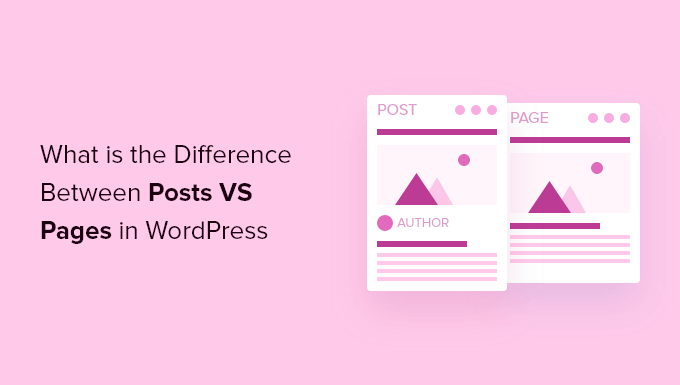
Aqui está o que discutiremos em nosso artigo:
- O que são Posts no WordPress?
- O que são Páginas no WordPress?
- Páginas vs. Posts no WordPress (Diferenças Chave)
- Posts vs. Páginas: Perguntas Frequentes (FAQs)
O que são Posts no WordPress?
Posts são usados para criar conteúdo de blog, artigos e outros conteúdos listados na sua página de blog. Eles são exibidos em ordem cronológica inversa, de modo que o conteúdo mais novo (seus posts mais recentes) é exibido no topo da lista.
Se você está usando o WordPress como um blog, então você provavelmente acabará usando posts para a maioria do conteúdo do seu site.
Você pode adicionar e editar seus posts do WordPress clicando na opção de menu 'Posts' no seu painel. Veja como é o editor de posts do WordPress.
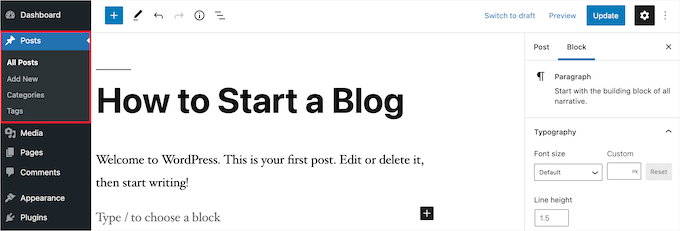
Por padrão, seus posts serão listados do mais recente para o menos recente. Dito isso, você também pode usar a ferramenta de post fixo do WordPress para destacar um post que você acha que todos deveriam ler.
Você também pode organizar suas postagens com base em categorias e tags, que são o sistema de taxonomia do WordPress. Isso ajudará os visitantes a encontrar conteúdo relacionado com mais facilidade e a navegar em seu site de forma mais eficaz.
Por exemplo, se você tem um blog de culinária, pode usar categorias como Aperitivos, Prato Principal e Sobremesas, e tags como Vegetariano, Refeições Rápidas ou Receitas de Feriado.
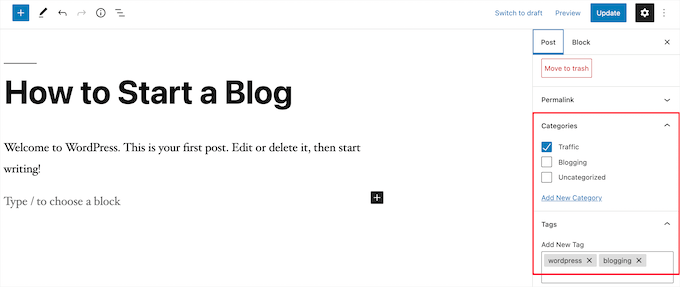
As postagens de blog também servem para incentivar conversas. Elas têm um recurso de comentários integrado que permite aos usuários comentar sobre um tópico específico.
Por padrão, comentários, pingbacks e trackbacks estão habilitados.

Você pode encontrar a seção de comentários após o conteúdo da postagem do blog. Por outro lado, o WordPress geralmente desabilita comentários em suas páginas.
As postagens do WordPress também exibem metadados da postagem. Essas informações são listadas após o título da postagem do blog em postagens individuais e em sua página de blog.
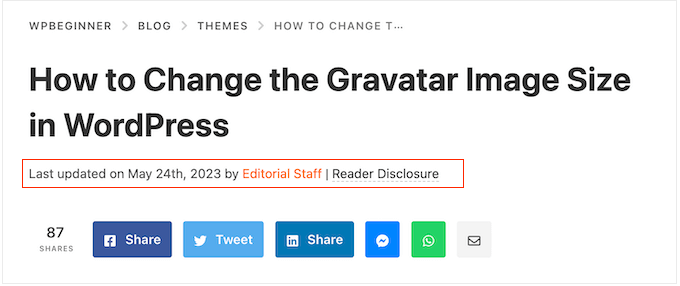
Geralmente, mostra a data de publicação, o nome do autor, as categorias, as tags e mais. Você pode personalizar completamente suas informações de metadados da postagem. Para mais detalhes, consulte nosso guia sobre como exibir metadados de postagens de blog em temas do WordPress.
Agora que você sabe o que são postagens do WordPress, vamos dar uma olhada nas páginas e como elas são diferentes.
O que são Páginas no WordPress?
Páginas são tipos de conteúdo estáticos "únicos", como sua página Sobre, política de privacidade, página de contato e mais. Embora o banco de dados do WordPress armazene a data de publicação da página, as páginas são entidades atemporais.
Por exemplo, sua página Sobre não tem data de expiração. Claro, você pode voltar e atualizá-la, mas é provável que você não tenha uma página Sobre 2012, página Sobre 2013, e assim por diante.
Temos todos os tipos de páginas estáticas no WPBeginner, como nossa página inicial, página comece aqui, página Sobre, página de contato, página de arquivo e páginas personalizadas como nossa página de ferramentas de negócios gratuitas.
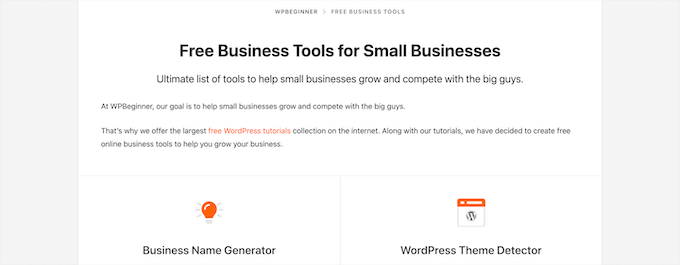
Você pode adicionar e editar páginas no seu painel de administração do WordPress clicando na opção de menu ‘Páginas’.
Veja como é a tela do editor de páginas.
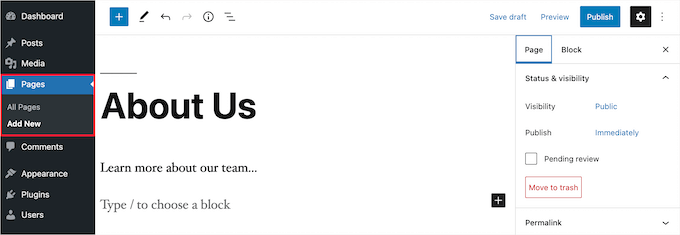
Páginas não são feitas para serem sociais, então geralmente não têm botões de compartilhamento social. Por exemplo, você provavelmente não quer que os visitantes compartilhem sua página de política de privacidade no Twitter.
Páginas também não incluem comentários. Você não quer que os usuários comentem no seu formulário de contato ou na página de termos de serviço. Existe uma opção para habilitar comentários. No entanto, ela está desabilitada por padrão para suas páginas do WordPress.
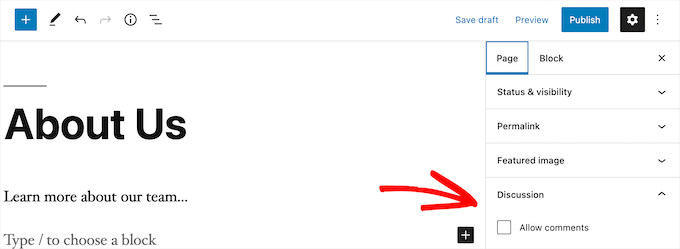
Ao contrário dos posts, as páginas são hierárquicas por natureza. Por exemplo, você pode ter subpáginas ou páginas filhas dentro de uma página.
Você pode facilmente transformar uma página em uma subpágina escolhendo uma página pai na seção 'Atributos da Página' ao editar uma página.
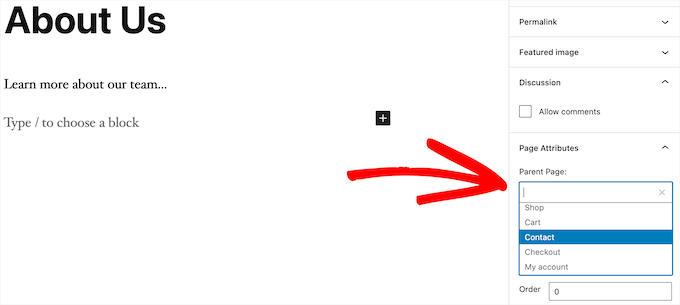
Além disso, você pode criar páginas WordPress completamente personalizadas com a ajuda de um plugin construtor de páginas arrastar e soltar para WordPress. Isso permite que você use layouts de página diferentes da opção padrão fornecida pelo WordPress.
Para mais detalhes, consulte nosso guia sobre como criar uma página personalizada no WordPress.
Páginas vs. Posts no WordPress (Diferenças Chave)
Um post é destinado a conteúdo que você publica regularmente, como posts de blog e artigos de notícias. Enquanto isso, uma página é destinada a conteúdo estático que não é atualizado com tanta frequência, como uma página inicial, uma página Sobre, uma página de contato, e assim por diante.
Aqui estão outras diferenças importantes entre posts e páginas no WordPress:
- Posts são oportunos e páginas são atemporais.
- Você pode usar categorias e tags para organizar posts, enquanto páginas são hierárquicas e organizadas como páginas filhas e pais.
- Posts têm um autor e data de publicação, enquanto páginas não.
Apesar dessas diferenças, existem algumas semelhanças entre páginas e posts no WordPress.
Primeiro, ambos são usados para publicar conteúdo. Você pode adicionar texto, imagens, vídeos, formulários e mais a posts e páginas. Há suporte para imagens destacadas em páginas e posts.
Você pode construir um site WordPress sem nunca usar posts ou os recursos de blog do WordPress. Você também pode criar um site de negócios com páginas e uma seção de blog separada para suas notícias, anúncios e outros artigos.
Posts vs. Páginas: Perguntas Frequentes (FAQs)
Abaixo estão algumas das perguntas mais frequentes que ouvimos de nossos usuários sobre posts vs. páginas e como usá-los corretamente no WordPress.
Quantos posts e/ou páginas posso ter no WordPress?
Você pode ter quantos posts e/ou páginas quiser. Não há limite para o número de posts ou páginas que podem ser criados.
Existem vantagens de SEO para posts vs. páginas?
Não totalmente. Em geral, os motores de busca gostam de conteúdo evergreen que é organizado e atualizado. Existem também ferramentas como AIOSEO para ajudá-lo a otimizar posts de blog e páginas para que ambos possam ranquear nas páginas de resultados dos motores de busca.
Em resumo, recomendamos que você concentre seus esforços em tornar seu site amigável e valioso para seu público-alvo. Para saber mais, consulte nosso guia definitivo de SEO para WordPress para iniciantes.
Adicionar páginas é semelhante a adicionar posts no WordPress?
Sim. O menu para adicionar páginas e posts no WordPress pode ser separado, mas o processo de criar um novo post e página é semelhante.
Para páginas, você pode ir em Páginas » Adicionar Nova na área de administração do WordPress. Enquanto isso, você pode criar uma nova postagem indo em Posts » Adicionar Nova. De qualquer forma, você será direcionado para o editor Gutenberg para começar a adicionar seus blocos de conteúdo.
Quais páginas devo criar no meu site ou blog?
Depende do tipo de blog ou site WordPress que você está criando. No entanto, você pode querer ver nossa lista de páginas importantes para todos os sites.
Posso alternar posts para páginas e vice-versa?
Muitos iniciantes acidentalmente adicionam conteúdo a posts quando querem criar páginas. Da mesma forma, alguns novos blogueiros podem acabar salvando posts de blog como páginas.
Se você está apenas começando, pode corrigir isso facilmente usando o plugin Post Type Switcher. Para mais detalhes, veja nosso guia sobre como alternar tipos de postagem no WordPress.
Existem outros tipos de conteúdo no WordPress além de posts e páginas?
Sim, existem. Esses outros tipos de conteúdo padrão incluem anexos, revisões e menus de navegação. No entanto, eles não são usados da mesma forma que posts e páginas.
O WordPress também permite que você crie seus próprios tipos de postagem personalizados. Esse recurso é usado por plugins para criar tipos de conteúdo adicionais no WordPress.
Por exemplo, se você administra uma loja online usando WooCommerce, você verá um tipo de postagem ‘Produtos’ na sua área de administração do WordPress.
Para mais detalhes, veja nosso guia passo a passo sobre como criar tipos de postagem personalizados no WordPress.
Esperamos que este artigo tenha ajudado você a aprender a diferença entre páginas e posts no WordPress e como usá-los. Você também pode querer ver nossos tutoriais sobre as diferenças entre uma landing page e um site e os melhores plugins de posts populares para WordPress.
Se você gostou deste artigo, por favor, inscreva-se em nosso Canal do YouTube para tutoriais em vídeo do WordPress. Você também pode nos encontrar no Twitter e no Facebook.





Sam Victor
Olá a todos,
Acabei de entender a diferença entre páginas e posts.
Obrigado, amigo.
Mark Cross
Como iniciante, este pequeno tutorial foi útil. Eu estava entrando em um blog padrão ao tentar criar um site. Espero chegar ao ponto de me mover entre o site, painel, visualização, publicação e outras ferramentas que o WordPress oferece. Então, é hora de começar a aprender.
forhad
Cada post deve estar em uma página, mas uma página contém muitos artigos.
sarath
Por favor, como você inseriu meta keywords em um site usado no WordPress?
Rita
Posso ter páginas que exibem posts diferentes em um blog?
Quero dizer, ter uma página com Notícias (atualizada diariamente) e uma página de Artigos (atualizada semanalmente). É possível fazer isso no WordPress?
Devo criar um tipo de post personalizado?
Monjur
Obrigado por um artigo incrível... toda a minha confusão sobre post vs página foi removida por este único artigo.
Alexander Okpara
Por favor, gostaria de saber como criar páginas diferentes do blog para posts diferentes
Shraddha Shakya
Olá!
Sou novo no WordPress e recentemente comecei um blog sobre fofocas de celebridades. Escrevi todo o conteúdo em páginas e depois as vinculei às postagens na página inicial. Não quero que as postagens sejam exibidas na página inicial. Então, postei uma postagem e depois as vinculei às páginas. Mas o problema é que minhas páginas não estão aparecendo no Google. Apenas as postagens são exibidas.
Então, é que as páginas não são exibidas no Google??
Minha página tem meio mês, então isso pode ser um motivo para o Google não exibi-la, mas uma postagem que tinha apenas 1 dia apareceu. Isso me preocupou.
Então, para aparecer no Google, qual é melhor, páginas ou postagens?
Pankaj Choudhary
por favor, verifique o código da sua página inicial e a configuração de leitura do wp, escolha uma página estática nas configurações de leitura do wordpress.
Subhendu
Qual é a diferença entre COMENTÁRIO E POST no Wordpress? Por favor, ajude.
Roy Randolph
Um Comentário é o tópico de discussão que você pode (se desejar) ter para uma página ou um post. Em outras palavras, você está comentando em um "Post" de Blog, por exemplo. Basicamente, é a mesma coisa que você está fazendo agora, você está comentando fazendo uma pergunta. Espero que ajude.
Ray Foucher
Sou novo no WP, acabei de iniciar um site WP e tenho um link no menu superior "Artigos" que vinculará a uma página listando todos os meus artigos (conteúdo estático) com descrições curtas de cada um e links para uma página individual para cada artigo.
A pessoa que hospeda meu site insiste que os posts são o caminho a seguir em vez de páginas. Estou acostumado a usar HTML para outros sites e não tenho problemas em construir os links. Gosto da ideia de poder ter minhas próprias descrições e ordem para a lista de artigos e não vejo as vantagens dos posts para isso. Alguma ideia?
Se eu usasse posts, acredito que poderia atribuí-los a uma categoria de artigos para mantê-los juntos, mas eu poderia então organizá-los na minha ordem preferida e escrever ou alterar minhas próprias descrições?
janz
Comecei a escrever em Páginas. Como faço para vincular uma página à próxima em ordem cronológica em cada Página publicada? Por exemplo, em posts, há um link para o post anterior e o próximo. Não consigo encontrar isso em Páginas. Você pode me ajudar, por favor?
WPBeginner Support
Por favor, dê uma olhada em nosso guia sobre a diferença entre posts e páginas no WordPress.
Você também pode querer conferir nosso guia sobre a diferença entre WordPress.org auto-hospedado vs blog gratuito WordPress.com.
Admin
neil henderson
Olá, estou desenvolvendo um site de férias e usando o WordPress. Tenho páginas de estilo de propriedade e depois também estou pensando em ter páginas de categoria (hotéis, chalés, acampamentos). Tenho considerado o seguinte formato:
páginas de propriedade como tipos de postagem personalizados
páginas de categoria com a capacidade de inserir listas de categorias (para poder formatar um pouco mais)
Eu estava apenas me perguntando, já que SEO é absolutamente crítico para este projeto funcionar, seria melhor eu fazer as páginas de propriedade como "páginas" e, se sim, é possível adicionar algum tipo de taxonomia a uma página para que eu possa puxá-las para uma página de categoria?
obrigado
neil
akhil raj shrivastava
olá a todos
Alguém, por favor, preste atenção no meu index.php. Tenho um menu, um banner, depois um slogan, o slogan com algum conteúdo sobre o site e três conteúdos sobre "leia mais", e uma opção de rodapé. O problema é este. De alguma forma, o conteúdo "leia mais" não é publicado, ou não é mostrado no index.php, mas eu criei "leia mais" na opção de postagem.
Alguém entende isso?
Onde estou errando?
Rados
Por favor, seja tão gentil em me ajudar a inverter a ordem de aparecimento de novas seções em uma página – quero que novas seções apareçam no topo, não no final da página. Muito obrigado desde já!
Ian Player
Obrigado por um artigo muito interessante. Também seria *muito* útil ouvir as razões pelas quais você escolheu escrever este artigo como uma Postagem em vez de uma Página. Obrigado!
Mikey
Que ótimo ponto! Este é um conteúdo muito atemporal ou "evergreen".
Suponho que a principal razão para publicá-lo como Postagem é que o autor quer que nós o compartilhemos! Como acabei de fazer no Twitter.
John Morris
Se eu li o artigo corretamente, você queria receber comentários e as postagens habilitam isso com mais facilidade do que as páginas. Além disso, este conteúdo pode mudar à medida que novos lançamentos alteram a funcionalidade. Apenas uma ideia.
Pat
Este é um post útil e muito claro. Mas ele não aborda a única questão sobre posts e páginas que realmente me confunde, como novato em WP. Se eu quiser adicionar produtos a um site WP, eles devem ser adicionados como Páginas ou Posts? No meu caso, os Produtos em questão são livros de vários autores. Se eu listá-los como Posts, os visitantes do site poderão usar Categorias para filtrá-los por Autor. No entanto, não consigo ver como adicionar a foto e as informações biográficas do autor à mesma página de resultados. E se eu listá-los como Páginas (para que eu possa ter uma seção com foto do autor e nota biográfica, etc.), não consigo ver como gerar e filtrar (através de Categorias) os resultados para que a página do Autor X mostre apenas os livros do autor X. Eu até tentei vários temas dedicados a livros e e-commerce, mas nenhum deles parece fornecer o que eu pensava que seria um ingrediente básico. Estou perdendo alguma coisa? Obrigado de qualquer forma pelo bom trabalho!
WPBeginner Support
Você pode querer conferir nosso guia sobre Por que você precisa de um tipo de post personalizado ou taxonomia no WordPress.
Admin
Prash
como fazer os posts recentes aparecerem no topo???
SHRADDHANSHU SHEKHAR
Escreva um post > veja CONFIGURAÇÕES na parte inferior, pressione IMEDIATAMENTE e decida em qual data e hora você quer que seu post seja publicado. depois publique. o post mais recente é mostrado no topo.
Randa
agora acho que estou comentando em um post e não em uma página!!!
WPBeginner Support
Sim.
Admin
Patricia
Incrível! Curto e direto ao ponto. Passei a noite inteira procurando no site de suporte do blog sem respostas… apenas para ter isso claramente explicado em um vídeo de menos de 2 minutos!
WPBeginner Support
Fico feliz em ajudar. Obrigado pelo feedback.
Admin
Hugh Boyde
Este artigo é muito útil. Tenho uma dúvida, no entanto. Tenho experimentado colocar Categorias no Menu, como descrito, para que certos posts apareçam em uma exibição única se você clicar em um determinado item do menu. Isso parece funcionar, EXCETO que os posts aparecem sem títulos, datas ou um local para o leitor deixar um comentário. Existe alguma maneira de exibir esses detalhes, por favor?
Suraj
Ei, é um ótimo artigo. Eu só queria saber uma coisa: se os sites, por exemplo, usam uma página ou post para fornecer conteúdo, estou realmente confuso porque existem plugins separados que permitem a um usuário postar como recurso em uma página.
Geri
Sou um novato total em WP… Posso perguntar como adiciono categorias aos posts? Por exemplo, Baking e Homestuffswedo
Entendo que os posts são categorizados em momentos diferentes, então espero conseguir categorizá-los em temas diferentes.
WPBeginner Support
Por favor, veja nosso guia sobre Categorias e Tags no WordPress.
Admin
Keith Gardner
Não entendo por que diabos você não gostaria de ter um template para um post, assim como teria para uma página. Tenho um site construído principalmente com páginas, e agora estamos tentando habilitar o blog, e ele se recusa a funcionar corretamente porque não há como especificar um template para posts. O site é baseado no Twenty Eleven. Algumas páginas (usando “template padrão”) são de largura total, outras (usando “template de barra lateral”) são de três colunas. No modo de três colunas, há uma “Barra Lateral Principal” à esquerda e uma “Barra Lateral Extra” à direita.
Criei uma "página de posts" para o meu blog, e isso também parece bom. Mas quando clico para ver um dos posts, vou para um formato de largura total, e o conteúdo da Barra Lateral Principal é colocado diretamente sobre o conteúdo do post. Não está em uma coluna à esquerda do conteúdo do blog, está bem em cima dele. No final do post, há o conteúdo da Barra Lateral Extra empurrado para o fundo.
Já arranquei o pouco cabelo que me restou por causa disso, e não estou mais avançado do que estava há dias. Alguém pode me fornecer links para ideias, soluções, contornos, situações semelhantes? Qualquer coisa?
E também, voltando à minha pergunta original, se isso é um "recurso" em vez de uma "falha", por que diabos as pessoas o desejariam assim? Estou perdendo alguma coisa aqui.
Obrigado.
Walid
Olá,
Obrigado pela explicação.
Posso saber se este artigo é um post ou uma página?
Obrigado
N
WPBeginner Support
É um post.
Admin
Equipe WPBeginner
Talvez o que você precise sejam categorias, não páginas.
Digamos que você tenha um site de notícias e queira que os posts apareçam nas páginas Notícias Locais, Esportes, Opinião. Você pode fazer isso criando categorias: notícias locais, esportes, opinião. Ao escrever um post, basta selecionar a categoria na qual deseja arquivar esse post.
Você também pode adicionar categorias para aparecerem no menu de navegação do seu site. Basta ir em Aparência > Menus e adicionar categorias ao seu menu de navegação. Agora, se alguém clicar em Esportes, irá para a página onde todos os seus posts relacionados a esportes aparecerão.
Lauren
Isso está alinhado com a minha pergunta. Eu tenho meus posts configurados para irem para as páginas de categoria corretas, mas uma vez lá, o post inteiro é exibido. Existe uma maneira de exibir apenas uma prévia ou uma grade após selecionar uma página de categoria? Para artigos de notícias, vejo como esse layout faz sentido. Estou postando receitas e gostaria que meus leitores pudessem ver uma grade de todos os meus posts e, em seguida, selecionar individualmente. Quando tentei usar o plugin Post Grid, ele fez com que todos os meus posts, independentemente da categoria, fossem exibidos.
MarionD
Como diabos se "posta" em uma PÁGINA ESPECÍFICA? Adicionar novo post faz com que ele vá para a terra do esquecimento do seu site. Deve haver uma maneira de adicionar um post apenas à página em que você deseja que ele seja visível. O que estou perdendo? Estou ficando muito frustrado com o WordPress. Parece nada intuitivo ou fácil de usar.
Justin Young
Adicione a categoria de posts ao menu. Adicione os posts que você deseja exibir a essa página.
Equipe WPBeginner
Você deve usar Categorias para organizar seus posts.
erika
obrigado, a explicação está clara. no entanto, acredito que o wordpress é complicado e não lógico. gostaria de usá-lo como um blog de viagens, então teria uma página para cada país e, claro, gostaria de poder ver meu post sob o país, no entanto, o post não aparece sob a página do país dada??? você pode explicar?
Chandu
Erica, tenho a mesma dúvida enquanto estou construindo um site de viagens, você pode me enviar um e-mail com detalhes sobre quantas páginas e posts você adicionou ao seu site, qual deles é mais amigável para SEO.
Por favor, compartilhe a hierarquia de páginas > posts
Syed Balkhi
Você pode tentar ocultar posts do seu template e removê-lo do plugin de SEO.
Capain Pat
Caro Syed, você me perdeu completamente. Conforme meu post acima, criei um site inteiro com "posts" em vez de "páginas". Sua resposta não está clara.
Capain Pat
Obrigado por este artigo. Eu construí alguns sites em WordPress, mas estou um pouco confuso. Escolhi "posts" em vez de "pages" há muito tempo. Não sei por quê. Mas notei que o Google mostra a data do post na prévia do snippet. Isso me preocupa, pois meus posts são atemporais e não específicos de um determinado momento. Eu preferiria não ver a data do artigo – estou preocupado que, daqui a cinco anos, as pessoas possam não ler meu artigo em preferência a uma "page" que não mostra data. Agradeceria qualquer sugestão sobre como mudar isso e os benefícios ou perigos de fazê-lo. Obrigado. Pat
Mark
A very clear explanation of the difference between posts and page
Joyce
Sou novo no WP e no seu site; ótimas informações. Agora tenho uma compreensão muito maior sobre a diferença entre os dois elementos de assunto (ou seja, Posts, Pages). Ainda assim, meu problema parece cair entre todas as ótimas informações que li aqui (e em alguns outros sites), que é qual a melhor maneira de lidar com meus artigos antigos (artigos reais e completos) do meu site Microsoft FrontPage. Não são muitos, então o trabalho manual não me incomoda. Quero que eles permaneçam prontamente disponíveis para os leitores. Parece que criar um novo "Post" para cada artigo não foi correto, pois, aparentemente, isso os apresentaria como "frescos ou novos" e até lhes daria uma nova data. Parei o que comecei, devido à incerteza. – Configurei meu Tema Genesis Lifestyle Pro para ter uma Página ESTÁTICA e "Posts" vai para um BLOG. Criei uma NOVA PÁGINA – não post – (por exemplo, "12 Old Articles Bucket") para conter os 12 links para os artigos individuais. Quanto aos 12 ARTIGOS, CRIEI uma NOVA PÁGINA (não um post) para cada um, e então, copiei/colei texto simples em cada um. Abri "12 Old Articles Bucket" e linkei para cada artigo. Adicionei "12 Old Articles Bucket" ao menu de NAVEGAÇÃO PRIMÁRIA.
Tecnicamente, está errado colocar o texto diretamente nas PÁGINAS (12) como fiz? Por um lado, parecia não haver como adicionar categorias ou tags fazendo isso. Li sobre artigos vs. posts, migrando de um sistema para outro, etc., mas essa questão parece passar despercebida. Espero "POSTAR" todos os artigos "novos" desta categoria como um Blog. Desculpe pelo tamanho. Obrigado.
David Scoggin
obrigado pelo artigo. Ainda não tenho clareza sobre isto: Quando você cria uma nova Página, você obtém um novo menu que abre essa página. É o mesmo com os Posts? Quando você cria um novo Post, você obtém um novo menu que abre esse Post?
Ou os Posts estão em Páginas?
Quando você quer uma "página" de Blog, você quer um Post, não uma página, certo? Cada nova entrada de Blog é um novo Post ou todos eles estão contidos em um único Post?
Obrigado
Sam
Concordo com a Stacy, este foi um post excelente e muito claro sobre o assunto. Dada a frase de pesquisa que usei, este artigo apareceu como resultado nº 2, mas foi muito superior à resposta oficial do próprio Wordpress, que por acaso foi o resultado nº 1.
Obrigado, agora eu entendi!
Steven Barnes
Post fantástico! Estou direcionando meus alunos de blog para cá para resolver o debate sobre qual é exatamente a diferença entre um post e uma página.
Stacy
Obrigado por informações tão claras! Trabalho online há 4 anos, estive em dezenas de listas para 'iniciantes' e ainda nunca tive posts vs. páginas explicados tão claramente como você fez aqui. Queria ter sabido isso no início, teria economizado dias de tempo! Obrigado novamente.
Andres
Obrigado,
Bem, eu assumo que se você tiver apenas 20 posts em uma categoria, eles nunca desaparecerão, a menos que você escreva novos posts que os empurrem para mais baixo na categoria. Eu estava apenas me perguntando o que acontece quando as pessoas escrevem muitos posts em uma única categoria? O WP os arquivará automaticamente em algum lugar ou simplesmente os deixará lá indefinidamente?
Eu não sei o que acontece com posts mais antigos à medida que o tempo passa e novas entradas começam a deslocar as antigas...
WPBeginner Support
seus posts permanecerão arquivados sob essa categoria. Dependendo do seu tema e das configurações do WordPress, sua página de categoria mostrará um número limitado de posts na página da categoria com um link para posts mais antigos na parte inferior da página.
Admin
Andres Rueda
Olá,
Tenho uma pergunta: o WordPress arquiva posts automaticamente após um certo período de tempo?
Quero criar uma galeria de imagens e quero escrever sobre cada imagem. Não sei se devo usar páginas ou posts. Eu gostaria de usar posts porque as pessoas podem dar suas opiniões e porque posso colocá-los em categorias diferentes, mas tenho medo que, se usar posts, eles desaparecerão eventualmente.
Quero criar uma categoria, adicionar um post com a galeria principal de imagens e depois escrever posts individuais explicando cada imagem da galeria. Farei isso para cada galeria de imagens. No final, cada categoria não deve ter mais de 20 posts ou algo assim.
Seria um erro se eu criasse todo este layout usando posts em vez de páginas?. Quero usar posts, mas como eu disse, tenho medo que depois de um tempo o wordpress os remova (ou arquive) automaticamente. Nesse caso, perderei todo o meu trabalho :(.
O que você recomenda?. Devo usar posts ou páginas?. Você pode explicar se o wordpress remove posts automaticamente após um certo período de tempo?.
Obrigado
WPBeginner Support
Andres, Por padrão, o WordPress exibe seus posts mais recentes na página inicial do seu site. Você está certo sobre usar posts porque com posts você pode usar categorias.
Se você quiser que alguns de seus posts permaneçam na página inicial, você pode usar o recurso Posts Fixos no WordPress. Outra solução possível é arquivar todos os posts que você deseja que permaneçam na página inicial em uma categoria "Posts em Destaque" e, em seguida, usar tags condicionais para exibir seus posts em destaque no topo. Alguns temas do WordPress vêm com funcionalidade integrada para posts em destaque também.
Admin
Mary Cahalane
Obrigado por um artigo claro e simples. Eu aprecio isso! Ainda fico um pouco confuso em relação a um aspecto de posts vs. páginas – se os posts são projetados para aparecer em uma página específica, isso significa que, se tivermos conteúdo que mudará, precisaremos criar algum tipo de codificação personalizada para que posts diferentes apareçam em páginas diferentes? Ou criamos novas páginas a cada vez e de alguma forma descartamos as antigas?
Estou trabalhando em um novo site para nossa organização – uma organização de artes. Portanto, novas informações serão criadas constantemente para novos eventos. Eu gostaria que essas informações fossem exibidas na página apropriada (por exemplo, galeria ou espaço de performance). Posso ver como eu poderia fazer muitas páginas funcionarem dessa maneira com bastante facilidade. Mas não tenho certeza de a) como você move isso quando o tempo acaba e b) se essa é a melhor prática, mesmo que seja a mais fácil.
WPBeginner Support
Mary, você pode organizar seu conteúdo em categorias como galeria, espaço de performance, etc. Ao criar uma postagem no WordPress, você pode escolher ou adicionar categorias. Você também pode adicionar essas categorias ao menu de navegação principal do seu site.
Admin
Kim
Obrigado por uma resposta concisa e clara para um novato como eu!
David
Obrigado, este artigo é muito útil e também os diferentes pontos de vista apresentados por Jason com as respostas dadas por Syed. Eu me encontro no meio, de iniciante a algo mais, mas ainda não sou um especialista, então nem sempre é fácil entender como criar ótimas landing pages com conexões de posts e assim por diante. Acho que está correto dizer para começar com o conhecimento escrito neste artigo como iniciante porque o risco é fazer uma bagunça em toda a organização do próprio site. Depois, suponho que você precise de um bom conhecimento dos conceitos que deseja compartilhar com seu blog e, em seguida, organizá-los bem entre posts e páginas, mas é algo que comecei a explorar e nem sempre é fácil de entender. Além disso, parece-me que seria melhor mudar o template de uma landing page para torná-la mais atraente, mas não sei se é algo muito fácil de fazer.
Equipe Editorial
David, obrigado por passar e deixar um comentário. Organizar entre posts/páginas é algo que você fará pela vida do seu blog. Quando o tópico ficar muito quente, ou você notar que escreveu muitos artigos sobre ele, então você pode criar uma landing page para isso. Alguns apenas usarão tags, outros criarão uma landing page manual para aparência/sensação.
Alterar o template da landing page exigiria que você criasse um template de página personalizado (necessita de conhecimento de HTML/CSS + temas do WordPress).
Admin
David
Obrigado pela sua resposta. Bem, tenho uma dúvida sobre como fazer isso. Por exemplo, escrevi um longo post sobre Instagram, com mais de 5000 palavras, e muitos artigos relacionados sobre esse assunto. Atualizo regularmente esse post e há mais de 600 comentários agora, e muitos links internos que apontam para outros posts relacionados. Neste ponto, acho que é tarde demais e suponho que esse artigo se tornou apenas uma landing page. Além disso, se eu criasse uma landing page para esse assunto agora, não criaria um conflito de palavras-chave entre o post principal e talvez a landing page?
Agora, estou criando outro guia longo (cerca de 6000 palavras) para outra rede social semelhante e não tenho muita certeza se devo criar uma postagem ou uma página de destino para isso, realmente não tenho ideia.
Então, estou pensando que provavelmente deveria criar apenas uma página de destino para todos esses tipos de guias juntos e apontar para todos os artigos longos internos, que apontam para todos os artigos menores.
Para o modelo, estou estudando Objective-C agora e não tenho tempo para encaixar outra linguagem na minha mente. Se for algo fácil, eu faria, caso contrário, esperaria para depois, obrigado de qualquer forma.
Rastrear
Raramente deixo comentários, mas este, eu não pude resistir. Refiro-me ao debate anterior entre Jason e Syed.
Posso dar um comentário honesto e imparcial, pois não sou de forma alguma um conhecido de nenhuma das partes e, além disso, sou um "iniciante".
Depois de ler a diferença entre "post e página", tenho que dizer que isso me ajudou tremendamente a ter uma base do que os dois fazem (ou quais são suas funções).
Dito isso, como iniciante, só posso garantir e dizer que foi útil para mim.
E depois de ler o comentário de Jason, obviamente faria mais sentido para alguém mais experiente em WP ou design de sites. Em outras palavras, confunde um iniciante como eu, então me chame de burro, lol.
Darshan Vapi
Obrigado WPB. Entendi o ponto, mas ainda não estou satisfeito em relação a SEO.
Você pode elaborar mais sobre isso, por favor?
Equipe Editorial
Darshan, os motores de busca gostam de sites organizados. Páginas podem ter uma boa classificação, mas se o seu site não estiver organizado, isso o prejudicará mais do que ajudará.
Admin
Kara
Muito obrigado!
Astrid
Olá pessoal,
Este post acertou em cheio! Muito claro e direto ao ponto. É engraçado porque, como ex-desenvolvedora que acabou de migrar meu site estático para WP, eu tinha essas dúvidas sobre postar ou adicionar uma página. Estou bem ciente da estrutura do site e de como organizá-la, então isso foi moleza. No entanto, onde realmente tocou foi a seção com "Posts vs. Páginas (Principais Diferenças)".
Quase me dá vontade de refazer minha página principal (Encontre sua condição) em posts ou algo assim. Sim, adiciono condições periodicamente, mas, honestamente, mantenho minha página do FB bem ativa e isso não direciona tráfego para onde eu quero.
Decidi que vou postar parte do conteúdo que, de outra forma, postaria no FB no meu blog a partir de agora, já que não estou recebendo muito tráfego. Você concorda? Adoraria ouvir algumas sugestões, pois estou preocupada, vendo a importância de posts atualizados.
Atenciosamente e obrigado(a) desde já
RW
Boa ideia, Astrid. Eu recomendaria postar seu conteúdo de notícias no seu blog e depois linkar para ele a partir da sua página do Facebook. Isso lhe renderá links/tráfego vindos da sua página do Facebook.
Obrigado...
Astrid
RW ~ Thanks for your feedback
Pergunta, por favor: Qual seria uma maneira eficaz de fazer isso? Via um widget ou simplesmente colando o link na minha página do FB? Se sim, qual widget você recomendaria?
Atenciosamente…
RW
O Facebook costumava permitir que sites de blog (plataformas como o WordPress) postassem automaticamente o conteúdo publicado na página do Facebook de um usuário. Acredito que eles mudaram a API e ainda pode ser possível, mas eu gosto de ter mais controle sobre o que vai para a minha página do Facebook.
Existem alguns bons plugins que pegam suas postagens e as publicam automaticamente no seu feed do Twitter, que pode ser configurado para postar no Facebook. Posso estar enganado sobre isso, mas é o que eu sei.
Leva apenas 5 segundos para copiar e colar o URL do seu blog no Facebook, e então você também pode editar a introdução do Facebook, então eu gosto do método manual para isso. Existem tantos plugins que valem a pena, que não acho que essa ação precise de um.
Obrigado.
Nando
Se você tem uma conta no Twitter, você pode realmente enviar sua postagem para o Twitter e, em seguida, do Twitter, postar no FB. É o que eu faço. Um plugin para postar em DOIS sites.
Robert Wilkins
Muito bem colocado. Simples, direto ao ponto e preciso! Bem feito.
Jean
Eu leio muitos artigos no WPBeginner e este é voltado para iniciantes. Muitos dos outros artigos são mais intermediários (eu diria), o que está bom para mim porque esse é o meu nível. Mas acho que muitos iniciantes "reais" achariam este artigo útil.
Eric
Sim, este artigo é muito útil, acho que esta é uma das perguntas mais populares que as pessoas me fazem quando começam um novo site WordPress.
Bem dito.
Navneet
Cara, esta postagem é incrível… Posso saber se a newsletter deste blog está no Aweber ou Mailchimp e se precisamos pagar por algum desses serviços.
Equipe Editorial
Estamos usando o MailChimp. Você pode ver a lista completa de ferramentas que estamos usando aqui: https://www.wpbeginner.com/blueprint/
Admin
Lisa Kalandjian
I work with a lot of businesses that are new to WordPress and this is definitely one area that creates a great deal of confusion among my clients. Personally I think you explained it very well
Jason Witt
Tenho que dizer que discordo deste artigo inteiro. Comparar Posts e Páginas é como comparar maçãs e dinamite.
“Posts” são uma ferramenta para publicação e “Páginas” são onde você exibe os “Posts”. À medida que você começa a se aprofundar no WordPress, começará a criar tipos de postagem personalizados para diferentes partes de um site, e terá que criar páginas para exibir esses Posts personalizados. O index.php e o single.php são páginas assim como as páginas personalizadas que você pode criar com o modelo de página, mas são apenas páginas com um propósito mais específico.
Este artigo só seria válido se alguém fosse usar o WordPress “apenas” como um blog, mas sejamos honestos, o WordPress evoluiu muito além de um simples blog. É um CMS, e há desenvolvedores que até começam a usá-lo como uma Plataforma de Aplicações.
Se eu não soubesse melhor, diria que este artigo foi escrito por alguém com pouco ou nenhum conhecimento das capacidades do WordPress. Este é um artigo realmente decepcionante vindo de um site em que passei a confiar para dicas e tutoriais relacionados ao WordPress.
Equipe Editorial
Olá Jason,
Este artigo é escrito na categoria guia para iniciantes para os iniciantes. Certamente, entendemos que o WordPress evoluiu como plataforma. No entanto, um bebê não começa a correr imediatamente. Eles têm que aprender a engatinhar, depois andar, e então eles podem correr. Sugiro que você veja alguns dos outros artigos da categoria e veja como eles cobrem o básico do WordPress. Esta categoria geralmente cobre itens que vêm prontos com o WordPress (na maioria dos casos).
Tipos de Postagem Personalizados não possuem uma interface visual para um iniciante brincar. Mesmo que tivessem, para utilizar seu poder máximo, eles precisariam escrever código. Seria uma grande ignorância de nossa parte assumir que todos são desenvolvedores. Desenvolvedores compõem uma parte muito pequena da indústria do WordPress. A maioria dos usuários do WordPress são apenas pessoas comuns (usando a plataforma) sem tocar em nenhum código.
Para você dizer que “Posts são ferramentas para publicar anúncios, Páginas são onde você exibe Posts” está correto e incorreto. Pela própria definição de “páginas da web”, tudo na web é uma página. Você não pode generalizar as coisas a esse ponto porque então estaríamos discutindo semântica. Uma página de arquivo seria uma página. O painel seria uma página. Tudo seria uma página. Isso não faria sentido para um iniciante porque não há como diferenciar. Agora, vamos olhar do ponto de vista do WordPress. Posts e páginas são ambos tipos de conteúdo personalizados, e eu preferiria não repetir o artigo inteiro aqui.
Quanto à exibição de tipos de postagem personalizados, sim, você os exibe em Páginas de Arquivo. Se você tiver que criar um modelo de página personalizado toda vez para exibir um tipo de postagem personalizado (há uma chance de você estar fazendo isso errado). Claro, há momentos em que você não quer ter uma exibição de arquivo de CPTs, e nesses casos você usa um modelo de página personalizado. No entanto, não é necessário usar uma Página e um modelo de Página para exibir tipos de postagem personalizados.
Espero que o que eu disse no comentário faça sentido. Eu administro este site desde 2009 e uso o WordPress desde 2006. Eu não publicaria algo se não achasse que seria útil para o público em geral.
Atenciosamente,
Syed Balkhi
Fundador da WPBeginner
Admin
Frederick
Acho que este guia é muito bom como uma introdução simples para iniciantes que usam o WordPress pronto para uso. Você está geralmente certo de que os CPTs não são algo que iniciantes provavelmente construirão.
No entanto, apesar da retirada da interface de formatos de postagem do 3.6, ainda discordo deste ponto:
No ponto técnico, você está certo de que os "modelos" são expostos para páginas, mas não para posts.
Em vez disso, temos formatos de postagem com diferentes visualizações de front-end, como Galeria, Vídeo e Citação. Estes não exigem codificação para um iniciante usar e funcionam com temas padrão e muitos dos gratuitos no Diretório de Temas.
Então, para resumir todas as formas de personalização:
– modelos de página: apenas páginas
– formatos de postagem: apenas postagens (certo?)
– tipos de postagem personalizados: eles não são nem postagens nem páginas, no sentido do core do WordPress!
Equipe Editorial
Frederick,
Devo esclarecer que, quando digo que as páginas têm modelos personalizados e os posts não. Significa que você pode personalizar cada página específica com um modelo diferente, se decidir. Muitos temas oferecem esse tipo de funcionalidade para páginas (ou seja, modelo de página de exibição, modelo de página inteira, etc.).
Formatos de postagem são uma forma mais ampla de categorização/agrupamento e estilização. É também um recurso muito mais novo, portanto, não é suportado por muitos temas. Antes dos formatos de postagem, os desenvolvedores usavam taxonomias personalizadas para conseguir isso.
Você está correto, este artigo tem como objetivo dar uma visão geral de posts vs. páginas para iniciantes.
Tecnicamente falando, um desenvolvedor pode adicionar funcionalidade de template às postagens se desejar. Frameworks de temas como o Genesis fazem isso através de post-meta e chamam de Layouts. Existem também plugins que permitem criar templates de postagem de forma semelhante aos templates de página. Aqui está um exemplo:
http://wordpress.org/plugins/single-post-template/
Como desenvolvedor, você pode estender posts e páginas praticamente da maneira que quiser com campos de meta. No entanto, as diferenças acima são destacadas para iniciantes, não para desenvolvedores, portanto, é importante mantermos as coisas simples e fáceis em vez de complicá-las demais.
-Syed
John Smith
Jason, Com todo o respeito – discordo. Este artigo não é sobre templates de página – sinto que foi escrito para atingir usuários que estão começando com o WordPress e tentando descobrir se devem ir para a parte de posts ou páginas do painel de administração para publicar seu conteúdo!
Acho que é óbvio que nem todo mundo que frequenta este site é um especialista – daí o nome 'wpbeginner'.
Trollando por acaso?